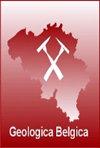A new geological map of the outcrop areas of the Brabant Massif (Belgium)
IF 0.7
4区 地球科学
Q2 GEOLOGY
引用次数: 5
Abstract
1. Introduction As a result of the “new geological map of Wallonia” program undertaken by the Walloon Government since 1990, the maps covering the entire southern outcropping part of the Brabant Massif (BM) have been finalised (Fig. 1). These 19 maps at 1/25 000 scale (12 full and 7 partial, Fig. 2; Annex 1), were realized between 1993 and 2017 by several teams of the universities of Brussels (ULB), Louvain (UCL) and Mons (Umons), with occasional input from experts from UGent and KULeuven. During the last two decades the authors’ research has been heavily focused on the geology of the Brabant Massif and they have contributed to the realization of half of these maps, particularly those that cover the Dyle and the Senne valleys (e.g. Verniers et al., 2005; Debacker et al., 2005b, 2011; Herbosch et al., 2008a; Herbosch & Verniers, 2013, 2014, 2015; see also Annex 1). Figure 1. (A) Position of the Brabant Massif within the Anglo-Brabant Deformation Belt (ABDB) along the NE-side of the Midland Microcraton (MM) in the context of Laurentia, Baltica, Avalonia and Armorica (modified after Winchester & PACE TMR Network team, 2002; Sintubin et al., 2009). Abbreviations: IS: Iapetus Suture; LCS: Le Conquet Suture; LNSM: Luneberg-North Sea Terrane; (MM): extension of the Midland Microcraton to the southeast under the Variscan Front; TS: Tornquist Suture; RHS: Rhenohercynian Suture; RS: Rheic Suture; VF: Variscan Front; WB: Welsh Basin. (B) Geological subcrop map of the Brabant Massif, a比利时布拉班特地块露头区的新地质图
1. 自1990年以来,瓦隆政府开展了“瓦隆新地质图”项目,涵盖布拉班特地块(BM)整个南部露头部分的地图已经完成(图1)。这19幅地图以1/ 25000比例尺绘制(12幅完整地图和7幅局部地图,图2;附件1),于1993年至2017年期间由布鲁塞尔(ULB),鲁汶(UCL)和蒙斯(Umons)大学的几个团队实现,偶尔也有来自尤金特和鲁汶大学的专家提供意见。在过去的二十年中,作者的研究主要集中在布拉班特地块的地质上,他们为实现这些地图的一半做出了贡献,特别是那些覆盖Dyle和Senne山谷的地图(例如Verniers等人,2005;Debacker et al., 2005b, 2011;Herbosch et al., 2008;Herbosch & Verniers, 2013、2014、2015;另见附件1)。(A)在Laurentia、Baltica、Avalonia和Armorica背景下,米德兰微克拉通(MM)北北侧盎格鲁-布拉班特变形带(ABDB)内布拉班特地块的位置(根据Winchester & PACE TMR Network team, 2002修正);Sintubin et al., 2009)。IS:足跖骨缝合线;LCS: Le conquest缝合;LNSM: Luneberg-North Sea Terrane;(MM):米德兰微克拉通在瓦里斯坎锋面下向东南延伸;TS: Tornquist缝合;RHS:雷诺西期缝合线;RS: Rheic Suture;VF: Variscan Front;WB:威尔士盆地。(B) Brabant地块地质亚作物图,a
本文章由计算机程序翻译,如有差异,请以英文原文为准。
求助全文
约1分钟内获得全文
求助全文
来源期刊

Geologica Belgica
地学-地质学
CiteScore
4.70
自引率
27.80%
发文量
8
审稿时长
>12 weeks
期刊介绍:
Geologica Belgica is a Belgian journal that welcomes papers concerning all aspects of the earth sciences, with a particular emphasis on the regional geology of Belgium, North West Europe and central Africa. Papers not dedicated to the geology of Belgium, North West Europe and central Africa are only accepted when one of the authors is linked to a Belgian University or Institution. Thematic issues are highly appreciated. In this case, guest editors take in charge the selection of the manuscripts and the subject of the papers can be enlarged. The journal is in open access.
Submitted manuscripts should be concise, presenting material not previously published. The journal also encourages the publication of papers from Belgian junior authors. Short letters are accepted. Papers written in English are preferred. Each mansucript will be reviewed by at least two reviewers.
 求助内容:
求助内容: 应助结果提醒方式:
应助结果提醒方式:


